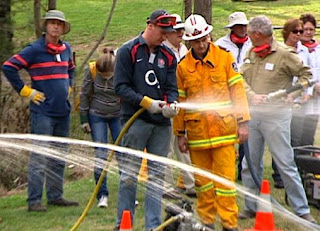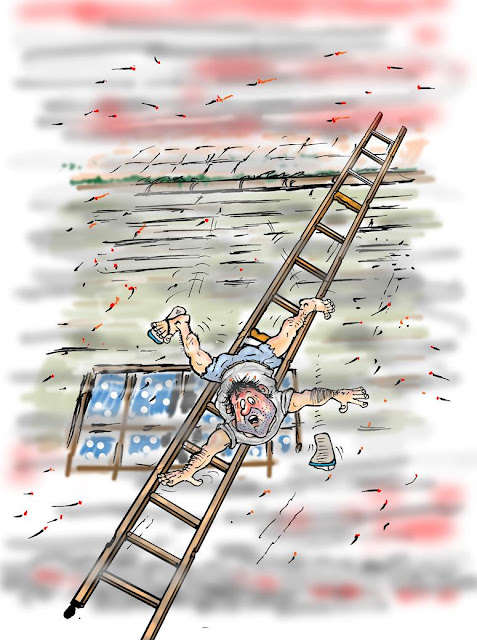Thank you to Kelwyn White, Community Protection Planning Officer, Batemans Bay for writing this article and doing all the consultation work
In October 2011, I began work on the Guerilla Bay Community Protection Plan (CPP) as one of four initial trial locations in NSW. Working in the Customer Service Centre in an area that wasn’t familiar to me was a huge change to doing community engagement at a District/Zone/Team office. With that in mind I knew that unless I built rapport with the community, local Brigades and the District, and developed those trust networks, consultation with the community would not be successful.
The Guerilla Bay community are familiar with the CPP concept as they had a Village Bushfire Mitigation Plan implemented about five years ago. I made contact with a community member that lives in Guerilla Bay, who was heavily involved with the development of the Village Bushfire Mitigation Plan and also contacted a member of the Malua Bay Rural Fire Brigade. These meetings were a great starting point. These two people introduced me to the Guerilla Bay community and provided me with contacts in the community I could consult about the CPP.
I then made contact with the President of the Guerilla Bay Association, giving them written information on what a CPP was and what it would provide for the Guerilla Bay Community. I asked the Association to promote the CPP to residents and arrange a community meeting. The Association set the meeting date and forwarded invites to all members. From there I was in regular contact with the President of the Association as we prepared to take the CPP to the community. Making contacts and getting some background information on the community was an important step to take before doing any other consultation.
 |
| Bush Fire Preparation Map, Guerilla Bay |
The next step was to meet with the local Malua Bay Rural Fire Brigade. I introduced the concept of CPPs and discussed the existing Village Bushfire Mitigation Plan, and examples of the Survival, Preparation and Operational Maps. I asked the Brigade to:
• highlight any concerns they had with operations in the Guerilla Bay area
• explain what they would like to see on the Operational Map
• provide comment on the existing mitigation measures in Guerilla Bay
• highlight any additional work they would recommend.
This meeting was also an opportunity to encourage the Brigade to attend the community meeting in Guerilla Bay, to show their support for the community and to continue building rapport between the Brigade and residents. The Brigade was really supportive of the planning process and looked forward to seeing the finished product and how they could put the maps to use operationally, for training and for community engagement activities. They were keen to be involved in the development and to work closely with the community.
The Brigade felt that one of the big advantages of the plan was that it would provide essential local information to Brigades assisting from other areas during a bush fire. The visitors would be able to get information on asset protection zones, bush fire risk, available access etc on a far more localised map than the current Village Bushfire Mitigation Plan.
My next port of call was the Eurobodalla Bush Fire Management Committee (BFMC). I introduced the process to all the members, gave them information on the development of the Guerilla Bay CPP and most importantly collected BFMC knowledge on Guerilla Bay.
The community meeting was held in January 2012 with 60-80 residents attending. Consulting the residents is the most vital part of the planning process, increasing their understanding of their bush fire risk, providing them information that will assist in the preparation of personal Bush Fire Survival Plans and giving them the opportunity to contribute to the development of the CPP.
As residents arrived, they were asked to put a sticker on the map to identify their property. Besides allowing us to see where people were from, it gave the residents an idea of the risk to their property.
The meeting was started with a quick survey to determine the resident’s thoughts, which had interesting results:
• 97.44 % believed they were at risk from bush fires in Guerilla Bay
• 79.49% already had a Bush Fire Survival Plan
• 92.31% had taken steps to prepare their homes
• 12.82% were members of the Guerilla Bay FireWise Group
• 64.10% were familiar with the existing Village Bushfire Mitigation Plan.
We then discussed the development of the CPP. The community had experienced a fire event in September 2009. We discussed how things could have been different had the fire been at a different time of year or started in a different location. We also talked about fire behaviour, Neighbourhood Safer Places and other safer locations.
We presented the community with examples of the Bush Fire Survival Map and Preparation Map, and invited the community to come up and view the maps, draw ideas on them and write questions for us. As the community had previously been involved in the development of a Mitigation Plan, they were keen to interact and take part in the discussion. Guerilla Bay is a very informed and educated community. This twenty minute exercise encouraged robust debate and clarified resident queries. The community really appreciated the lengths we went to consult with the majority of them over the holiday period.
 |
| Bush Fire Survival Map, Guerilla Bay |
Residents were very interested in safer places, as Guerilla Bay only has one access road and no Neighbourhood Safer Place. They were also very interested in warning systems, because there is poor mobile phone reception in the area. They discussed the feasibility of having some sort of formal signal, such as a flag on their letter box, to let fire fighters know that they were home and defending their property. Residents’ concerns about large logs and fallen timber that remained after hazard reductions was reduced after we explained that they weren’t a significant fire hazard on their own. Another concern was the reliability of mains water supplies during a fire.
Through this process, we learnt more about community demographics and the community’s informal plans for action during fire events. When asked about the location of vulnerable residents, everyone agreed that they didn’t want to be considered as ‘vulnerable’. It was understood that everyone knows who they are and where they live, and it was generally felt they would be looked after if a fire occurred. Following the meeting we discussed the option of mapping where vulnerable residents live, but question whether this then means that we are then accepting the responsibility to help them, which may not be possible during a fire and isn’t really the job of the Brigades.
The meeting was concluded with a post meeting survey to determine if the information presented had changed the resident’s ideas:
• 12.82% now believed they were at greater risk of bush fire than before the meeting
• 79.49% were going to review or develop their Bush Fire Survival plan
• 69.23% were going to take additional steps to prepare their homes for bush fire
• 33.33% wanted more information on FireWise Groups
• 92.31% believed that the CPP was going to enhance their own planning
• 15.38% asked for specific follow up from the Rural Fire Service.
After the meeting we have continued to have regular contact with the Association to distribute clarification on queries raised at the meeting, and to update them on changes to the CPP. The BFMC endorsed the CPP on 1 March 2012. We can now start promoting and implementing the plan!
 Play it safe this summer, and always check if a Total Fire Ban is in force. Read about Total Fire Bans on the NSW Rural Fire Service website.
Play it safe this summer, and always check if a Total Fire Ban is in force. Read about Total Fire Bans on the NSW Rural Fire Service website.























